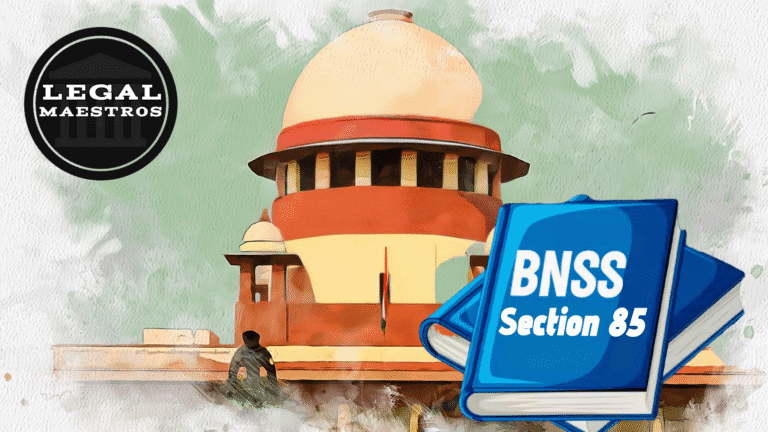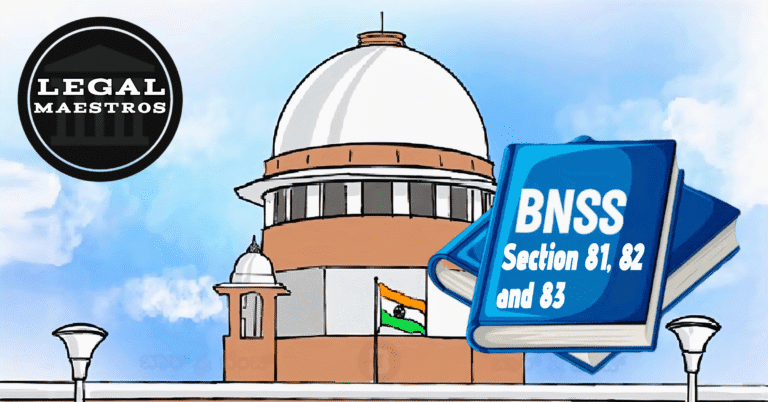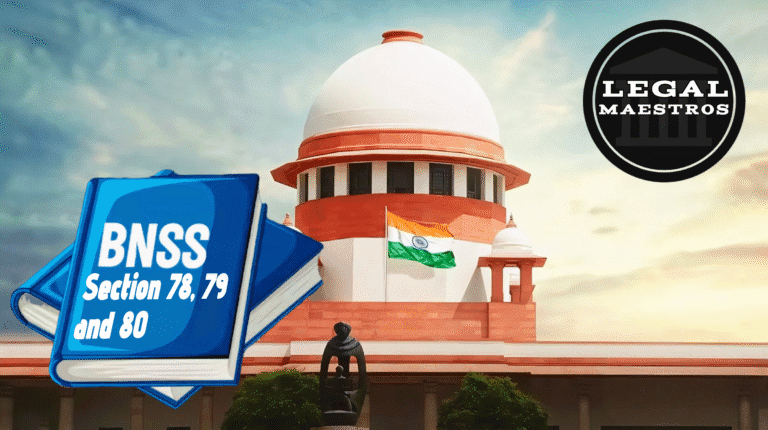
Section 84 – Proclamation for Person Absconding under the Bharatiya Nagarik Suraksha Sanhita, 2023
In the year 2023, the Bharatiya Nagarik Suraksha Sanhita presents a comprehensive legal framework with the purpose of ensuring justice and preserving public stability. Section 84 plays a crucial role in this regard because it establishes a clear method for dealing with those who abscond or hide themselves in order to avoid being arrested after a warrant has been issued against them. This section offers a structured process via which the court can publicly warn such individuals and pursue additional legal action if they fail to reply to the notification of the potential legal action. Additionally, the clause includes the authority to declare such individuals to be proclaimed offenders upon the fulfillment of specified circumstances.
(1) The Proclamation That Is Being Issued by the Government
In accordance with the provisions of subsection (1), the court is authorized to issue a written proclamation in the event that it has reasonable grounds to think that a person against whom a warrant has been issued has either fled or is hiding in order to hinder the execution of the warrant. It is essential to have a clear understanding that this belief can be developed by the court based on the evidence that is available or even without formal evidence, which enables the court to act rapidly when the circumstances require it to do so.
Once this belief has been formed, the court has the ability to publish a proclamation that requires the individual to present at a particular location and time when it is specified. On the other hand, the date that has been confirmed for the appearance must be at least thirty days after the date that the proclamation was published. This time frame not only gives the individual a reasonable amount of time to appear before the court, but it also guarantees that the procedure is carried out in accordance with the principles of natural justice.
For any queries or to publish an article or post or advertisement on our platform, do call at +91 6377460764 or email us at contact@legalmaestros.com.
Example: [Figure] Let’s say that a person by the name of Ramesh is accused of committing a financial crime. He is the subject of a warrant that has been issued by the court. However, when the police seek to carry out the warrant, they find that Ramesh is not at the address that is known to them and is purposefully avoiding being arrested. In light of the findings from the police, the court is of the opinion that Ramesh has fled the scene. As a result, the court issues a proclamation in accordance with Section 84(1), which mandates that he appear before the court within a period of thirty days.
Subsection (2) refers to the method of publication.
The procedure that must be followed in order to publish the proclamation is described in detail in subsection (2). This procedure not only ensures that the notice is sent to the person who has absconded, but it also provides the general public with information regarding the legal status of the individual. Included among the methods are:
Public Reading in the Neighborhood it is required that the proclamation be read aloud in a public setting in a prominent location within the municipality or village in which the individual typically resides. The public reading helps to ensure that nearby inhabitants are aware of the proclamation and may be able to aid in locating the individual or individuals in question.
For any queries or to publish an article or post or advertisement on our platform, do call at +91 6377460764 or email us at contact@legalmaestros.com.
Affixation at Residence and Public Places: The proclamation must be fastened to a visible part of the individual’s house or homestead, or to a location that is easily visible to the public in the town or village. For the second time, this guarantees that the notification is visible to other individuals who might be aware of the whereabouts of the person.
Affixation at the Courthouse: In addition, a copy of the proclamation must be fastened to a prominent location within the courthouse. Court officials and visitors are provided with this information regarding the status of the person who has absconded.
Additional Publication in a Newspaper: In addition, the court may decide to order the proclamation to be published in a daily newspaper that is distributed in the area where the individual resides. This action is available at the discretion of the court, and it may be taken if the court determines that additional publicity is required to ensure that the individual is informed.
For any queries or to publish an article or post or advertisement on our platform, do call at +91 6377460764 or email us at contact@legalmaestros.com.
The police read the proclamation aloud in public in Ramesh’s hometown after the court issued the proclamation. This occurred after the court issued the proclamation. In addition, they hang copies of the notice on his house, as well as on the notice board in the village and the bulletin board at the district court. In addition, the court orders that the notice be published in a regional newspaper in order to increase its widespread dissemination.
Third Subsection of the Proof of Publication subsection
Furthermore, the legitimacy of the publication process is guaranteed by subsection (3). A written statement by the court stating that the proclamation was published on a certain day, in the manner stated under sub-section (2), will be considered conclusive proof, according to this provision. As a result, there is no need for any additional evidence to demonstrate that the proclamation was published in the appropriate manner.
Through the implementation of this regulation, court procedures are simplified, and superfluous litigation about the process of delivery of proclamation is avoided. Following the court’s confirmation that the appropriate procedure was followed, it removes the burden of proof from the prosecution.
For any queries or to publish an article or post or advertisement on our platform, do call at +91 6377460764 or email us at contact@legalmaestros.com.
For example, in the instance of Ramesh, the court makes a statement that the proclamation was published on a particular date in accordance with the established legal procedure. In conclusion, this remark is seen as conclusive evidence that the proclamation was published in a lawful manner.
Section 4 of the Declaration of the Individual as a Proclaimed Offender
Another essential component of Section 84 is the fourth subsection. In the event that a person fails to appear in court, even after a proclamation has been issued, and if that person is accused of committing a major offense—more particularly, an offense that is punishable by imprisonment for 10 years or more, life imprisonment, or death—then the court has the authority to designate that person a “proclaimed offender.”
Prior to making such a pronouncement, the court is required to carry out an investigation however it deems appropriate. For the purpose of determining whether or not the individual had received actual notice and had knowingly chosen not to attend, this investigation may encompass the examination of evidence, police records, and other pertinent information.
For any queries or to publish an article or post or advertisement on our platform, do call at +91 6377460764 or email us at contact@legalmaestros.com.
There are major legal repercussions that come with being declared a proclaimed offender, which is why this step is rather important. It gives the state the ability to take more rigorous steps, such as attaching property in accordance with other sections of the law.
Illustration: Ramesh is facing charges under a legislation that could result in a sentence of up to twelve years in jail. He does not show up within the allotted period, despite the fact that the proclamation and all public notices have been made of him. Following the verification of the publication and the consideration of the gravity of the allegations, the court has decided to declare Ramesh to be a proclaimed criminal.
In the case of the Proclaimed Offender Declaration, the application of subsections (2) and (3) is provided in subsection (5).
When a proclaimed offender is declared in accordance with subsection (4), the procedural protections and obligations that are outlined in subsections (2) and (3) are extended to include the declaration of the offender. This indicates that the declaration, also known as the proclamation, must be disseminated in the same manner as the proclamation, which includes public reading, affixation, and maybe publication in a newspaper. A formal statement from the court regarding the publication in question will once again be considered conclusive proof.
For any queries or to publish an article or post or advertisement on our platform, do call at +91 6377460764 or email us at contact@legalmaestros.com.
This ensures that both stages are consistent and procedurally fair. The first stage involves calling the individual to appear, and the second stage involves proclaiming them a proclaimed offender if they do not comply with the requirements.
In the case of Ramesh, the court mandates a publication of this declaration after he has been labeled a proclaimed criminal. This ensures that the public is aware of the situation and that a correct legal record is kept.




![Research Assistantship @ Sahibnoor Singh Sindhu, [Remote; Stipend of Rs. 7.5k; Dec 2025 & Jan 2026]: Apply by Nov 14, 2025!](https://legalmaestros.com/wp-content/uploads/2025/11/Gemini_Generated_Image_s0k4u6s0k4u6s0k4-768x707.png)
![Karanjawala & Co Hiring Freshers for Legal Counsel [Immediate Joining; Full Time Position in Delhi]: Apply Now!](https://legalmaestros.com/wp-content/uploads/2025/11/Gemini_Generated_Image_52f8mg52f8mg52f8-768x711.png)
![Part-Time Legal Associate / Legal Intern @ Juris at Work [Remote]: Apply Now!](https://legalmaestros.com/wp-content/uploads/2025/11/ChatGPT-Image-Nov-12-2025-08_08_41-PM-768x768.png)
![JOB POST: Legal Content Manager at Lawctopus [3-7 Years PQE; Salary Upto Rs. 70k; Remote]: Rolling Applications!](https://legalmaestros.com/wp-content/uploads/2025/11/ChatGPT-Image-Nov-12-2025-08_01_56-PM-768x768.png)